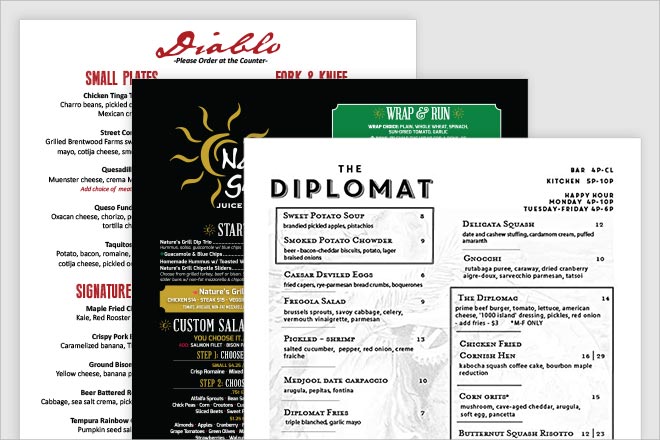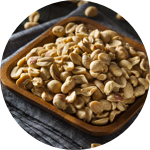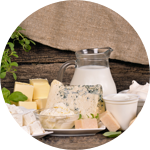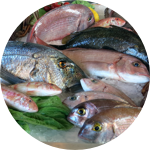How to write a menu for your restaurant

Writing a menu can be a challenge. Primarily because you have to get what’s in your chef’s head out of the kitchen and onto paper. Chefs speak a different language than your customers, and while a flambé or jus may be naturally understandable to them, you don’t want your customers to be scratching their heads when it comes to making a choice from your menu.
How much writing is too much?
When they go for a meal, guests will want to talk to each other rather than trying to decipher a complicated menu. The figure varies massively by time of day, type of cuisine, and style of restaurant, but the general consensus is you have under two minutes to explain the dishes you have available in writing.
“Customers will spend an average of 109 seconds reading a menu. This is the time limit you have to get your message to them.”
Restaurant Resource Group »
If you apply an average reading speed of 200 to 250 words a minute to that equation, you’ve got around 400 words to play with when writing a menu. This can even be reduced further by around 25 percent to account for decision making time.
Suddenly the intricately detailed explanation of your grilling process doesn’t seem quite so important.
Make it easy for your guests
Now that you have a rough idea of how much copy is appropriate, you can start to work out where explanation is and isn’t necessary.
Show everything at once
Don’t use up those precious seconds by making guests flick from page to page or open various flaps and folds on your menu.
Don’t waste words
For some items, keeping a title without description is enough. A pepperoni pizza is a pepperoni pizza, no matter how you try to embellish it.
Focus on three core ingredients
Unless they’re allergens, not every grain of salt needs to be mentioned. Stick to a main ingredient, a core flavor, and a primary herb or sauce.
Avoid long origin stories
If you want to explain all about the locally sourced ingredients you used, consider creating a separate section of the menu rather than attaching it to each dish.
Choose the right terminology
Describing something as ”crispy” is much more appetizing than ”fried.” Enhance a few phrases, but don’t alienate anyone with unnecessarily complicated language.
When writing a menu, it’s important to know your demographic and tailor the tone and reading level to them. Hiring a professional writer is a good idea, at least for the first menu version. Crafting menu copy is as fine an art as putting a meal together — you wouldn’t leave an untrained chef to run your kitchen so you should apply the same due diligence to your menu copywriting.
Important menu inclusions
Allergies are a serious consideration and there are various regulations around your responsibility to tell guests what’s in their food, either with words or symbols and a clearly labelled key.
The most common allergies are:

Nuts

Peanuts

Milk

Shellfish

Soy
While you may not legally need to display the calorie content of your meals until you hit your twentieth restaurant, it’s worth considering whether it’s a valuable inclusion anyway. Guests are increasingly making health-conscious menu choices, so listing which are healthy versus those a little more ”hearty” can make their decision simpler.
It’s also worth paying particular attention to how you label menu items as ”for two” or indicate waiting times are expected for dishes that require special preparation.
Deciding on what to include on your menu also raises the question of what to leave out.
“Guests given a menu without dollar signs spent significantly more than those who received a menu with them.”
The Center for Hospitality Research »
Using design to steer decisions
There will be certain items on your menu you want to steer diners towards, usually because they’re more profitable for you. There are various typographies, emphases, and callouts you can apply to your menu to draw the eye down the page, and it’s useful for you to understand the basics of menu layout theory.
The sweet spot
This changes slightly by how many panels your menu uses, but most menu designers will put a featured item in the upper right-hand corner.
F-shaped reading patterns
People read horizontally from the top left, decreasing how far they read into each line the further down they go. The first few words on the left of each line receive more attention than the rest.
Item ordering
When looking at a vertical list of dishes, the first and last items are those that customers spend the most time looking at, which means they’re usually the biggest sellers.
CAPITALIZATION
It’s more difficult to read copy when the caps lock has been left on. Using this for the name of the dish is fine, but aim for proper sentence case for descriptions.
Photography
One per dish, one per category, one per menu, or none at all? While customers often associate photos with lower-end restaurants, some choice illustrations can add a touch of class.
Colors, fonts, and the material used for your menus will all have an influence on how your menu is perceived, but ultimately it boils down to making your meals appealing, in the simplest way you can.
Rewards Network® does not provide tax, legal, or accounting advice. This material has been prepared for informational purposes only, and is not intended to provide, and should not be relied on for tax, legal, or accounting advice. You should consult your own tax, legal, and accounting advisors before engaging in any transaction.








